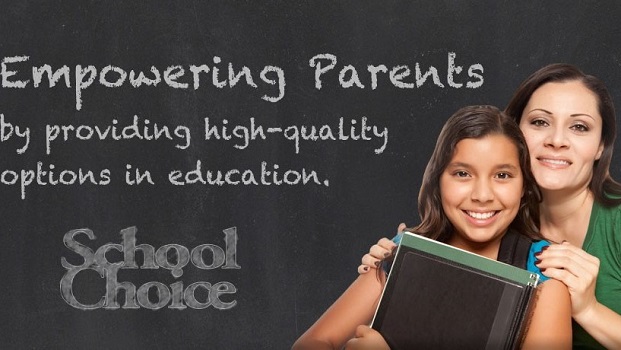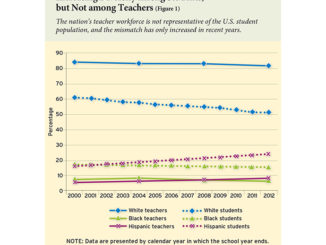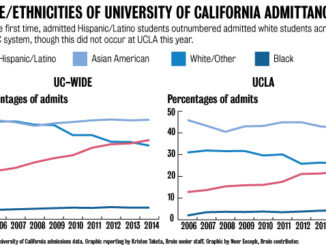
Education Next talks with Nonie Lesaux and Juan Rangel
Immigration reform and controversial efforts such as the DREAM Act have long been at the forefront of the nation’s political conversation. Today nearly one-quarter of K‒12 students in the United States hail from Spanish-speaking families or communities, and their needs have taken on a prominent place in our schools. In this forum, two experts argue that getting smarter about literacy and charter schooling offers big opportunities to address the challenges facing Hispanic youth. Juan Rangel is CEO of United Neighborhood Organization (UNO) and president of the UNO Charter School Network. Nonie Lesaux is professor of education at the Harvard Graduate School of Education, where she conducts research on language interventions for students with diverse linguistic and cultural backgrounds.
Juan Rangel: Emphasize Civic Responsibility and Good Citizenship
Over the past quarter century, a wave of immigration from Latin America, legal and illegal, has caused a divisive political debate in the United States on how to address its various implications. As our nation wrestles with the immigration issue more broadly, a concern raised across the political spectrum is how the public schools can best educate immigrant students. The debate is further polarized by differing views on assimilation of Hispanic immigrants.
Some wonder whether these immigrants will ever learn English and assimilate into American society, as past immigrants have done. Others question whether pushing America’s newest arrivals toward assimilation is even a good thing.
Unlike the experience of past immigrants, for today’s millions of Hispanic children the public schools no longer serve as the mechanism for their assimilation as Americans. Never mind that immigrants continue to chase the classic American dream. Never mind our nation’s motto, E pluribus unum (of many, one). Assimilation, Americanization, and patriotism seem to have no place in the academic lexicon of our nation’s public schools.
This is bad for our country and worse for immigrants and their children, especially for the growing Hispanic community. Isolating people is never a good strategy for building communities, cities, or a country.
Schools Should Play a Key Role
As was the case with previous immigrant groups, Hispanic immigration carries a set of serious challenges that will test our community’s ability to prosper in the United States. Deep investments in family, civic involvement, and, especially, in the education of our youth will be the key to our success.
America offers its citizenry opportunities for success, not guarantees. No one understands this more than immigrants who seek those opportunities every day. But to have access to those opportunities, immigrants need to be well positioned through deliberate assimilation strategies, specifically, through attending great public schools. This means more than the usual “safety net” of specialized services and demands a fresh approach that rejects a “victim” mentality.
A successful assimilation school model does not have to be unique to immigrant children. A quality public school that emphasizes civic responsibility and good citizenship will suffice to transition immigrants successfully, challenging them and the rest of us on our joint commitment to the welfare of our nation.
Key to this model is understanding the role that public schools play, not only in educating our youth, but also in serving as the mediating institution to successfully transition immigrant families into the American way of life, into making American values, culture, norms, and language their own. All American public schools ought to serve such a purpose, as they once did. Public schools can serve as powerful anchors to local communities, instituting a cycle of achievement and self-development at the grassroots level and instructing immigrants on the expectations placed on them as participants in American society.
Focus on Citizenship
Some will argue for a highly specialized program, curriculum, and staffing to educate Hispanic immigrant children. I beg to differ. There is no better cure for the social ills of our community and no better process for the education of an immigrant class than providing a great teacher, a core curriculum, a disciplined school culture, and strong accountability. These are sorely missing in America’s public schools, hurting all children, especially immigrant students.
Hispanic immigrant children need better public schools built around a curriculum that emphasizes American civics and citizenship. If a civics program is important for our nation’s future leaders across the board and to our democracy, it is more so for an immigrant community that is in a state of transition and whose youth struggle with issues of identity and belonging.
Our nation needs to recommit to the idea of building “one-nation … indivisible,” and the public school system should be central to this strategy. Unfortunately, there is no national will to welcome and integrate immigrant families into the American mainstream. Our willingness to wave the white flag on the words “assimilation” and “Americanization” not only weakens our ability to build on the indomitable spirit of immigrants, but also gives a pass to a gang and high school–dropout subculture among our youth that frightens both immigrant families and middle-class Americans, who worry about the welfare and future of their nation. The gang violence that plagues many of our communities and its schools is not inherent to Hispanics; it is a downward spiral version of American assimilation taking hold.
I recognize that any intentional “Americanization” effort is perceived in some quarters as denying people the right to maintain their heritage. Let’s be clear: these concepts of “Americanization” and “assimilation” do not demand the sacrifice of immigrant culture, history, language, and tradition. Our society and its schools ought to celebrate the rich history of our communities and aim to build on immigrant experiences to produce the latest example of an American success story.
The UNO Model
The United Neighborhood Organization (UNO), the community group that I lead in Chicago, and its network of charter schools provide Hispanic immigrant families with access to a high-quality education, thereby challenging them to fulfill their great potential while promoting American values, ideals, and our collective successes. Ours are not Hispanic schools; they are classic American schools, which serve all its students, including Hispanic immigrant children.
Immigrants and native-born Americans alike recognize English as a unifying feature of American society and as a key to immigrant advancement. Poor English-language skills not only delay full assimilation for our community, but also deny Hispanics full access to American opportunity. UNO chose English-language immersion over the traditional bilingual transition program to teach English to its children and families.
Structured English-language immersion challenges the conventional approach to educating English language learners (ELL). Our students’ limited English-language skills could easily be used as an excuse for low performance or a need for unlimited resources, but we see it as a necessity for teachers to differentiate their instruction to reach all learners, including ELL students. Most pragmatically, English immersion is effective in closing the performance gap between ELLs and their peers nationwide, and is financially viable and scalable—unlike the many bilingual transition programs that require untenable complements of teachers and resources and produce mixed results at best.
I believe, and our schools’ performance bears this out, that a well-rounded, rigorous program with excellent teachers and leaders works with any population of students, and works especially well for Hispanic immigrant children. UNO’s approximately 6,500 students are 95 percent Hispanic, 93 percent low-income, and 38 percent ELL (far exceeding the Chicago school average of 16 percent).Yet our schools consistently outperform the Chicago Public Schools on state tests (see Figure 1).
Events such as Election Day mock voting, Veteran’s Day Memorial program, and our 9/11 Remembrance take place throughout the year and are integrated into our rich curriculum, which includes classes in physical education, music, Spanish, art, and technology in addition to the core subjects of reading, math, science, and social studies. Our high-school students are required to take four years of Mandarin language class. Successful outcomes for UNO’s 13 charter schools include high-school and college readiness, as well as critical-thinking skills.
UNO’s approach is rooted in our unwavering high expectations for everyone, and in commonsense decisions grounded in data. For example, we extended our school day to 7.5 hours and lengthened the school year to 191 instructional days to ensure that all students receive adequate and quality instructional time. Student data on our interim assessments clearly showed a drastic annual “summer slide” that took until December to make up. To combat the slide, we serve as a model for districts across the country by employing a hybrid year-round calendar that shortens the summer to just five weeks. Our data suggest that after the first year on this new calendar, the slide has been eliminated in mathematics and drastically reduced in reading.
We believe in holding ourselves accountable. This year we are implementing a new performance-management framework for teachers that will provide them with comprehensive data on areas of strength and areas that need development, as well as reward high-performing teachers with bonuses as large as $14,000. This system combines important qualitative practice scores, quantitative growth and achievement data, school and network factors, as well as a community and parent engagement factor.
UNO’s success also depends on building a strong, stable relationship between home and school. Throughout our organization, from our teachers to me, we are responsible for partnering with parents to produce great outcomes for students. We expect much from our students’ parents. UNO teachers conduct two home visits each year to create the trust necessary for us to challenge families and be challenged in return. For immigrant parents who value the “Maestra” (Spanish for master or teacher), home visits reinforce the value of education.
Simply put, the facets of a quality school model with high expectations will work for all students, regardless of race, ethnicity, or immigrant or socioeconomic status. The absence of high-performing public schools, and the lack of emphasis on American civics or expectations for good citizenship, will hurt our nation’s youth and will certainly handicap our Hispanic immigrant students and their families most by impeding the assimilation process.
The good news is that we have seen this story before in our nation’s history with great outcomes. Hispanic immigrants are not unique to this narrative. It is, however, a uniquely American story being reenacted with new protagonists.
Nonie K. Lesaux: Focus on Higher-Order Literacy Skills
After years of attention from educators but little measurable achievement growth, something more has to be done to address the instructional needs of Hispanic students. The opportunity gap between Hispanics and their more-advantaged peers is still too wide, and high-school graduation rates are still too low. What’s more, demographic trends indicate that there is no time to waste: the Hispanic population is not only the nation’s largest immigrant group, but has accounted for 56 percent of U.S. population growth in the past two decades. As a result, linguistic diversity is increasingly characteristic of today’s classrooms. Unless educators design instruction to match the demographics of today’s students, as the Hispanic population continues to grow and to grow up, so too will the number of students experiencing difficulties. With this knowledge, policymakers and practitioners alike are eager to determine how to bolster English-language literacy among the Hispanic population at scale.
Hispanic Students in Context
Focusing education reform plans more effectively requires an understanding of context, in this case, key characteristics of the Hispanic population and the schools they attend. For example, the majority of Hispanic students in today’s classrooms are not “newcomers,” enrolling as older children and adolescents, but instead are U.S.-born children of immigrants. These families often associate the U.S. with better opportunities and a better life for the next generation, based on education and schooling. They enroll their young children in early education and care settings and kindergarten classrooms and think favorably about the U.S. public education system (see “Reform Agenda Gains Strength,” features, Winter 2013).
Yet, whether Hispanic children receive English-as-a-second-language support or not, many of them are performing well below average by middle-school entry. At the same time, Hispanic students in the U.S. are overwhelmingly growing up in poverty and attending high-minority schools, in which many of their peers are also at-risk for school failure. The 2011 8th-grade National Assessment of Educational Progress (NAEP) shows that only 18 percent of Hispanic students and 14 percent of black students read at or above proficiency levels. These populations also post higher rates of grade retention and lower rates of high-school graduation than their majority-culture peers. In the U.S., Hispanic and black students are attending increasingly segregated and underresourced schools. According to a 2012 report by the Civil Rights Project, 80 percent of Hispanic students and 74 percent of black students are enrolled in economically and racially segregated schools. Classrooms in these schools provide them with fewer opportunities to learn than their peers from higher-income backgrounds enjoy.
How does this inform my perspective on educating Hispanic and black students? On the one hand, it’s inappropriate to assume that similar performance patterns mean similar needs. There is no question that Spanish-speaking Hispanic students’ language-learning needs are somewhat different than their monolingual peers, particularly in the early years. For example, while many black children begin developing English oral-language skills years before formal schooling, many Hispanic children must develop English language proficiency as they are simultaneously learning academic content. Thus, although both groups may post lower rates of school readiness, Hispanic children from Spanish-speaking homes face the additional challenge of learning the language of the classroom, making them especially vulnerable to poor academic outcomes. To be competitive in this global economy, this population requires reform efforts that reflect their complex language-learning needs and builds on their strengths. On the other hand, there is reason to believe that the approach to bolstering students’ advanced literacy skills, and academic language skills in particular, need not be entirely different for different groups, particularly with increasing grade levels. This is especially the case when they are enrolled in the same schools in low-income neighborhoods, irrespective of language background or identification with a particular racial group. For example, a recent study conducted in urban middle schools found that there were more similarities than differences in the reading profiles of struggling students from non-English-speaking and English-speaking households, and that low academic vocabulary knowledge, a major component of advanced literacy skills, was a shared source of difficulty.
Seeking Advanced Literacy Skills
If we take seriously the ways in which literacy skills drive academic success, focusing immediate reform plans on bolstering these skills makes good sense, and that tack has been widespread. In this regard, current challenges to educating Hispanic students reflect a need we have recognized in public education for decades—not just to develop students’ literacy skills, but to develop their advanced literacy skills. Recent research, however, has shifted our thinking: It’s not reading per se that impedes Hispanic students’ advanced literacy skill development; it’s actually the language of print—in the newspaper, the textbook, the magazine article—that proves difficult and demands instructional emphasis. Our task, then, is to redesign our model for teaching literacy. We’ve gone about much literacy reform guided by the assumption that if we focus on the act of reading—putting the letters and sounds together to read words—then students will engage in deep comprehension. The flaws in this approach have proven particularly problematic for academically vulnerable populations, including many of our Hispanic students.
Why make this distinction between the act of reading and the language of print? Well, simply knowing how to read individual words is not enough to comprehend text. Students also need to understand the vocabulary used and the concepts the words describe. Otherwise, “reading” the printed page will not result in comprehension or learning. Schools have done a good job teaching most students the basic skills necessary to be proficient readers in the early grades, decoding and comprehending the conversational language that conveys ideas and topics in beginner books. Among those reaching this level of mastery are many Hispanic students and others who come from homes where the primary language is not English: they acquire early reading skills on par with their peers. Many of them surpass the “survival English” stage—they are conversant and comfortable speaking English—especially after many years in American schools. Still, with increasing grade levels, the language of print is beyond their reach; it is much less conversational and much more academic, making the texts far more difficult to comprehend.
The academic language of print is, at once, a gatekeeper and a gateway. When academic language is largely inaccessible, so too is the school curriculum; accessing the language, however, means having the opportunity to learn academic concepts and generate ideas and questions that contribute to academic conversations, and ultimately leads to school achievement. Beyond the language of the middle-school or high-school text, academic language is the language of the SAT, the college classroom, and the skilled labor force. It is a powerful tool for personal and professional success.
And yet we have never designed literacy instruction to support this language learning at scale. Instead, we’ve devoted most of our instructional resources and energy toward early literacy initiatives and supplemental interventions that have focused on reading print. In fact, without high-quality academic language learning and instruction, individual students’ literacy growth is impossible.
Implications for Education Policy and Practice
The school leader’s challenge, then, is to ensure that teachers have acquired the knowledge and the tools to create appropriate learning environments for student language development. This is especially the case in high-poverty settings with large numbers of Hispanic students. Today’s teachers report feeling underprepared to meet students’ language-learning needs effectively and typically have little to no training in how a student develops language. Professional development should outline strategies for integrating sophisticated, abstract vocabulary and language instruction into formal daily lessons, but also present ways to build language during informal interactions and thereby elevate overall language use in the classroom. In the end, unless a school, from the earliest grades to the latest, organizes around strengthening language and literacy for Hispanic students and all their classmates, we simply are never going to catch all of the students who may be struggling.
A larger challenge for policymakers and education leaders is to rethink the specialist model as the panacea for augmenting instruction for English language learners in today’s linguistically diverse schools, many with large concentrations of Hispanic students. It is neither feasible nor effective to rely solely on a model that serves only those learners who qualify because they have the lowest levels of English proficiency and who receive supports often only for a brief period of time, either in a classroom designed expressly for them or in a small group setting at particular times during the week. Instead, the academic growth of the entire population depends upon strong and supportive language- and content-rich classrooms day after day and year after year. It is only with this kind of time-intensive, high-quality effort in all classrooms that we will be able to support all Hispanic students—whether designated as “English proficient” or not—to develop the advanced literacy skills needed for high-school graduation and well beyond.
For academically at-risk students who have been enrolled in U.S. schools since kindergarten and who have experienced educational opportunities that are basically similar in design and practice, research suggests that a classroom-wide, universal approach focused on building up academic vocabulary and conceptual knowledge would be appropriate. The past decade has seen a relative surge in research conducted in urban, underperforming schools focused on doing exactly this— providing students with deep, language- and content-based instruction, with a focus on teaching both specialized vocabulary and the specialized structures of language in academic speech and text. Besides testing effective approaches to meeting student needs, this research helps keep pace with the standards-based accountability movement. Indeed, today’s Common Core standards mandate that instruction attend to the inherently complex challenge of building students’ background knowledge and academic language.
What, exactly, does effective, quality academic language instruction look like? Most often, it is text—the medium that is challenging for these learners—that is the best platform, anchoring the work in rich content. The instruction also maintains a sustained focus on producing oral and written language, such as generating extended research projects or essays, and engaging in academic discussion. Such practices are largely absent from elementary and secondary classrooms. In these purposeful language-rich environments, students have access not only to texts, but also to collaborative experiences, such as labs, demonstrations, and debates, which promote academic conversation and knowledge building. And although such an approach is promising, as with any instructional reform strategy designed to bolster at-risk students’ skills, the key in implementation will be accommodating differences, not only between linguistic and racial groups but also within them, while maintaining relentless attention to quality.
This article is part of a forum on how to best educate Hispanic students. For another take, please see “Emphasize Civic Responsibility and Good Citizenship,” by Juan Rangel.




